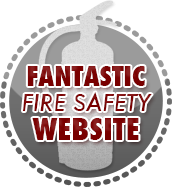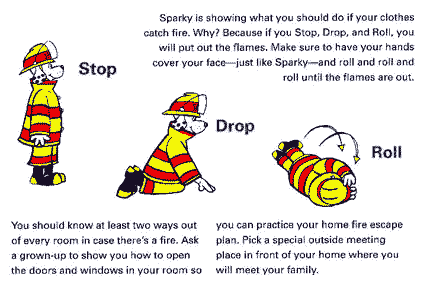Fire Extinguisher : 101
Basic Firefighting Tips
| Home |
| About Fire Extinguishers |
| Using a Fire Extinguisher |
| Fire Prevention |
| Fire Hazards |
| First Aid for Fire |
| Financial Protection |
| Biggest Fires in History |
| Firefighters |
This site was voted:

by onlinefiresciencedegree.org
(scroll to 74 on the list)
This page is intended to provide individuals with general information pertaining to some basic firefighting tips. |
All fires can be very dangerous and life-threatening. Your safety should always be your primary concern when attempting to fight a fire.
Before deciding to fight a fire, be certain that:
 The fire is small
and not spreading. A fire can double in size within two or three minutes.
The fire is small
and not spreading. A fire can double in size within two or three minutes.
- You have the proper fire extinguisher for what is burning.
- The fire won't block your exit if you can't control it. A good way to ensure this is to keep the exit at your back.
- You know your fire extinguisher works. Inspect extinguishers once a month for dents, leaks or other signs of damage. Assure the pressure is at the recommended level. On extinguishers equipped with a gauge, the needle should be in the green zone - not too high and not too low.
- You know how to use your fire extinguisher. There's not enough time to read instructions when a fire occurs.
How to Fight a Fire Safely:
- Always stand with an exit at your back.
- Stand sevevvral feet away from the fire, moving closer once the fire starts to diminish.
- Use a sweeping motion and aim at the base of the fire.
- If possible, use a "buddy system" to have someone back you up or call for help if something goes wrong.
- Be sure to watch the area for awhile to ensure it doesn't re-ignite.
Never Fight A Fire If:
- The fire is spreading rapidly. Only use a fire extinguisher when the fire is in its early stages. If the fire is already spreading quickly, evacuate and call the fire department.
- You don't know what is burning. Unless you know what is burning, you won't know what type of fire extinguisher to use. Even if you have an ABC extinguisher, there could be something that will explode or produce highly toxic smoke.
- You don't have the proper fire extinguisher. The wrong type of extinguisher can be dangerous or life-threatening.
- There is too much smoke or you are at risk of inhaling smoke. Seven out of ten fire-related deaths occur from breathing poisonous gases produced by the fire.
Any sort of fire will produce some amount of carbon monoxide, the most deadly gas produced by a fire. Materials such as wool, silk, nylon and some plastics can produce other highly toxic gases such as carbon dioxide, hydrogen cyanide, or hydrogen chloride. Beware - all of these can be fatal.
Smoke inhallation or exposure to fire itself can be life threatening so get educated about the basics in CPR and burn treatment.
 |